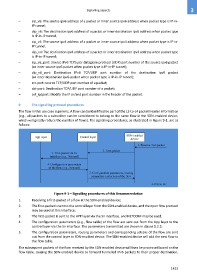Page 1433 - 5G Basics - Core Network Aspects
P. 1433
Signalling aspects 3
– sip_v6: The source ipv6 address of a packet or inner source ipv6 address when packet type is IP-in-
IP tunnel;
– dip_v6: The destination ipv6 address of a packet or inner destination ipv6 address when packet type
is IP-in-IP tunnel;
– sip_v4: The source ipv4 address of a packet or inner source ipv4 address when packet type is IP-in-
IP tunnel;
– dip_v4: The destination ipv4 address of a packet or inner destination ipv4 address when packet type
is IP-in-IP tunnel;
– sip_v6_port: Source IPv6 TCP/user datagram protocol (UDP) port number of the source ipv6 packet
(or inner source ipv6 packet when packet type is IP-in-IP tunnel);
– dip_v6_port: Destination IPv6 TCP/UDP port number of the destination ipv6 packet
(or inner destination ipv6 packet when packet type is IP-in-IP tunnel);
– src-port: source TCP/UDP port number of a packet;
– dst-port: Destination TCP/UDP port number of a packet;
– set_ip/port: Modify the IP or/and port number in the header of the packet.
9 The signalling protocol procedures
The flow in this use case is generic. A flow can be identified by part of the L2-to-L4 packet header information
(e.g., all packets to a subscriber can be considered to belong to the same flow in the SDN-enabled device,
which will greatly reduce the number of flows). The signalling procedures, as illustrated in Figure 9-1, are as
follows:
Figure 9-1 – Signalling procedures of this Recommendation
1. Receiving a first-packet of a flow at the SDN-enabled device;
2. The first-packet is sent to the control layer from the SDN-enabled device, and the open flow protocol
may be used at this interface;
3. The first-packet is sent to the APP layer via the Sn interface, and NETCONF may be used;
4. The configuration parameters (e.g., flow table) of the flow are sent out from the App layer to the
control layer via the Sn interface. The parameters transmitted are shown in clause 8.2.2;
5. The configuration parameters, routing parameters and corresponding actions of the flow are sent
out from the control layer to SDN-enabled device. The SDN-enabled device will add the new flow to
the flow table.
The subsequent packets of the flow received by the SDN-enabled device will then be processed based on the
flow table, causing the SDN-enabled device to forward tunnelled IPv6 packets to their proper destination.
1423

